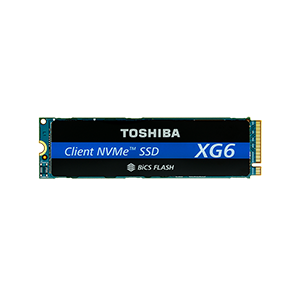Please select your location and preferred language where available.
Toshiba Memory introduces XG6 series with industry's first SSD using 96-layer 3D flash memory
New XG6 client NVMe SSD offers improved performance and power efficiency for PC, server and embedded applications
- Düsseldorf, Germany 24 July 2018
Toshiba Electronics Europe GmbH has introduced a new lineup of solid state drives (SSDs) that are based on its 96-layer, BiCS FLASH 3D flash memory. The first SSD to use this breakthrough technology[1], the new XG6 series is targeted to the client PC, high-performance mobile, embedded, and gaming segments – as well as datacentre environments for boot drives in servers, caching & logging, and commodity storage.

As the inventor of flash memory and the first to introduce the concept of 3D flash memory, Toshiba Memory is driven to continually push the boundaries of what is possible – and move the technology forward. Its 3-bit-per-cell (triple-level cell, TLC) BiCS FLASH technology improves the performance, density and efficiency of SSDs. And its innovative 96-layer stacking process combines with advanced circuit and manufacturing technology to achieve a capacity increase of approximately 40 percent per unit chip size over 64-layer 3D flash memory.
"The introduction of the XG6 series paves the way for Toshiba client, datacentre and enterprise SSDs to migrate to 96-layer technology", comments Paul Rowan, Vice President for the SSD business unit of Toshiba Memory Europe about the game-changing capabilities of Toshiba Memory's continued enhancements to its BiCS FLASH technology.
He continues, "Ideal for client, embedded and datacentre use cases, the new XG6 NVMe SSD series are versatile drives with capacity options of up to 1TB and optimised controller design for greater performance and power efficiency. Toshiba Memory is at the forefront of 3D flash memory development with 96-layer BiCS FLASH."
The new XG6 series is available in an M.2 2280 single-sided form factor and supports PCI Express[2] Generation 3x4 lane and NVM Express[3] revision 1.3a. A powerful combination of efficiency and performance is a hallmark of the XG6 series, which consumes 4.7W or less of power and reaches up to 3,180MB/sec of sequential read[4] and nearly 3,000MB/sec of sequential write, and up to 355,000 random read and 365,000 random write IOPS[5]. Achieved by optimising SoCs, the sequential write performance of the XG6 series leads the industry.
Additional Features Include:
- Security: Pyrite or self-encrypting drive models supporting TCG Opal Version 2.01, as well as support for block SID and digital signature
- Support for user-selectable over provisioning feature through NVMe command
- Top-of-the-class sequential performance (client class)[6]
- Enhanced SLC buffer to improve drive performance for client workloads
"The industry continues to transition to higher densities of 3D flash technology, with 3D NAND petabytes growing at a CAGR of 75 percent out to 2022," said Greg Wong, Founder and Principal Analyst of Forward Insights. "The introduction of 96-layer is an important milestone for flash to meet the increasing demand for faster and denser storage."
Well-suited to a wide range of read-intensive applications that prioritize power efficiency, burst performance and a compact footprint, the XG6 series will be available in capacities of 256, 512 and 1,024 gigabytes[7][8]. The new SSDs are currently sampling to select OEM customers and will be demonstrated at the Flash Memory Summit in Santa Clara, California from August 7 – 9 in Hall A, booth #307.
Notes
[1] Based on a Toshiba Memory Corporation survey as of July 23, 2018.
[2] PCI Express is a registered trademark of PCI-SIG.
[3] NVM Express is a trademark of NVM Express, Inc.
[4] Toshiba Memory Corporation survey based on sequential read and write speeds of 128KiB units, using XG6 1024GB models under Toshiba Memory Corporation test conditions. Read and write speed may vary, depending on the host device, read and write conditions, and file size. Toshiba Memory Corporation defines a megabyte (MB) as 1,000,000 bytes and a kibibyte (KiB) as 210 bytes, or 1,024 bytes.
[5] Toshiba Memory Corporation survey based on random read and write speeds of 4KiB units, using XG6 1024GB models under Toshiba Memory Corporation test conditions. Read and write speed may vary, depending on the host device, read and write conditions, and file size. IOPS is Input Output Per Second (or the number of I/O operations per second).
[6] Based on Toshiba Memory Corporation survey as of July 23, 2018.
[7] Definition of capacity: Toshiba Memory Corporation defines a gigabyte (GB) as 1,000,000,000 bytes. A computer operating system, however, reports storage capacity using powers of 2 for the definition of 1GB = 230 bytes = 1,073,741,824 bytes and therefore shows less storage capacity. Available storage capacity (including examples of various media files) will vary based on file size, formatting, settings, software and operating system, such as Microsoft Operating System and/or pre-installed software applications, or media content. Actual formatted capacity may vary.
[8] Product density is identified based on the density of memory chip(s) within the Product, not the amount of memory capacity available for data storage by the end user. Consumer-usable capacity will be less due to overhead data areas, formatting, bad blocks, and other constraints, and may also vary based on the host device and application. For details, please refer to applicable product specifications.
###
About Toshiba Memory Europe GmbH
We, Toshiba Memory Europe GmbH, are the European business of Toshiba Memory Corporation. Our company offers a broad product line of flash memory products, including SD Cards, USB flash drives, and embedded memory components, in addition to solid state drives (SSD). Our company maintains offices in Germany, France, Spain, Sweden and the United Kingdom. President is Masaru Takeuchi.